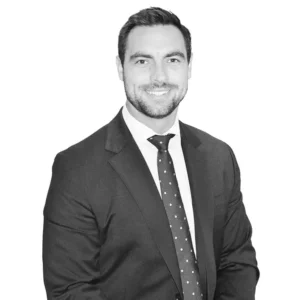A couple days a week I play pick up basketball with a group of guys. As you can imagine, over time you become friends with these folks – learn about each other’s families, careers, vacations, etc. You know, typical small talk between games. Last Saturday, I was chatting with an old friend while waiting for a game and he was telling me about seeing one of the guys outside of the gym and how unrecognizable people can be when seen in a different setting and not in gym clothes.
Me: “Did you see him on the weekend with his family?”
Friend: “No, I saw him at his office, when I was in there visiting another friend”
Me: “Oh, where does he work?”
Friend: “_blank__ Insurance Company.”
** I visibly cringed **
Friend: “What’s that look for?”
The cringe was totally reactionary and then I had to go on to explain myself and skillfully navigate my critique of this company, knowing that my basketball peer and a friend of a friend work there. I explained that in my experience as an advisor, I’ve come across a lot of clients that have been served by the said company. In almost all of these occasions, I’ve seen a collection of products that were sold without relation to a real financial plan and typically not the best solution for that client. I concluded with this, “It bothers me that this company promotes themselves as a financial planning centric organization, via commercials and how they present themselves to the community, but in practice, they really just pitch the products they produce.”
Then the light bulb went off, what a great article for TOM – what exactly is a FIDUCIARY?
And, off we go…
From Fitness to Finance to Fiduciary
As I have shared in the past, prior to the finance industry I worked in the fitness industry. The transition to becoming a financial advisor was a tough road. I guess you could say that I “started” at an insurance company, but in reality, I was only there for a day due mostly to the realization of what I was being asked to do – sell the companies products, rather than partake in real financial planning. Then it was off to retail banking, figuring this could be a foot in the door to becoming an advisor. This particular bank now makes headline news for its scandalous sales tactics (Bloomberg: “include opening bogus accounts, charging improper mortgage rate-lock extension fees and forcing insurance policies on auto-lending customers.”) and they recently wrote a check in the tune of $575 million to settle all the claims and accusations. So while those parts of the road were rough, I guess I have those experiences to thank for my career path of becoming a financial advisor. Soon after my time in banking, I found my way to what is called a “wirehouse” (a full-service broker-dealer) and my business card finally read, “Financial Advisor.” It felt like I was finally there, the place I had worked so hard to get to.
Whiteboard Lessons
Even though those initial experiences in finance were egregious, even my time at the wirehouse revealed some obvious conflicts of interest. It’s important to remember that not all financial advisors operate as a fiduciary. You might be wondering, what exactly is a fiduciary? Well, the textbook definition (courtesy of Investopedia) is:
“A fiduciary is a person who acts on behalf of another person, or persons to manage assets. Essentially, a fiduciary is a person or organization that owes to another the duties of good faith and trust. The highest legal duty of one party to another, it also involves being bound ethically to act in the other’s best interests.”
This definition does truly say it all, but this video and the analogy provided really did it for me. I’ve probably watched this clip a couple dozen times:
The video summed up my opinion that I was trying to share with my friend on the basketball court,
“The problem is that most people think that their butcher is a dietician.”
For me, being an industry insider, this is typically pretty easy to differentiate the two, but for a lot of my friends and folks outside of the industry, this isn’t so obvious.
The Environment Matters
Now, this isn’t to say that all advisors that work at a wirehouse or some particular insurance company are not acting in a fiduciary-like manner in a majority of their day to day dealings. Much of being a fiduciary is birthed from an inner desire to do the right thing. I know from experience, that there are good people at these places – I worked with a lot of them.
Here’s a key difference though, sometimes it’s the environment that tends to lead good people astray. I remember during my retail banking days that the company had an internal slogan, “Eight is Great.” This meant that they wanted the bankers to make sure each customer had eight products with the bank. The idea was that if the bank had more “wallet share” then the customer retention rate would be greater – more products led to stickier clients. The bank manager would literally approach me after each interaction and inquire about all of the products I presented. I wasn’t very good at this because I just didn’t believe it was the right thing to do. Seriously, take a moment to name eight products that a bank could potentially present to a client… Let’s see… (1) checking (2) savings (3) credit card (4) mortgage (5) insurance… I have trouble even thinking of eight, let alone believing this bank was the best solution for a client in all of those areas. Needless to say, my happiest day there was the day I resigned.
From Cultural to Structural
Now, the above was an example of how culture can influence bad behavior – the “Eight is Great” mantra, the micromanagement of the client interactions, and the incentive plans around cross-selling. There are also structural matters that create these conflicts as well. Think about it this way, when you come to a financial services company there are three primary services that you will need as client: a place to hold (custodian) your investments, things to invest in (stocks, bonds, mutual funds, etc.), and someone to provide advice (an advisor). When you have a company that attempts to do all three of these things on your behalf, you’ll typically see a conflict of interest introduced. Why? Because all three services: the custodian of assets, financial products, and financial advice are profit based businesses in themselves. When these are vertically integrated, you aren’t often getting the best of all three, but rather just all three from one place. This was my experience at the wirehouse and I could name countless examples of these subtle or not so subtle conflicts, but why not another whiteboard video instead:
The Reactionary Cringe
So, back to the beginning of our story. I really didn’t intend to have that look on my face or that reaction, but when I combined the bad experiences that I had, it became immediately clear that I had a chip on my shoulder.
Readers, please know that this story is mine and mine alone. I, in no way, wish to disparage anyone in the finance business who is not a fiduciary. As I described earlier, it was only after being on the “other side” that I can offer my perspective and compare the key differences between the two. I love my clients and truly want the “best” for them and I know that the environment I place myself in does affect them. And I do believe that every advisor should be held to the highest standards.
From time to time during a conversation with a prospective or existing client, this question arises, “What would you recommend we do if you were in our shoes?…”
I guess the moral of this story is that I LOVE being able to answer this question with confidence knowing that my answer is honest AND it also contains the legal and ethical accountability that being a fiduciary provides.
*************************************************************
Well… That’s all we got for you here this week at TOM. I hope you enjoyed it and please do email any questions or ideas for what you’d like us to write about. You can contact me directly at tcummings@thebahnsengroup.com. As an old teacher once told me, “Just ask the question because I’m sure many others have the same question and everyone will benefit from the answer.” So, in that spirit, ask away! 😊





